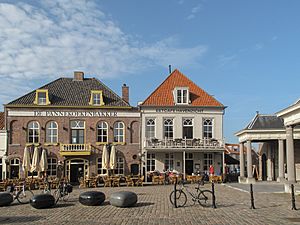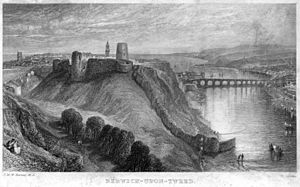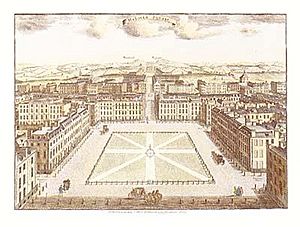Roger Handasyd facts for kids
Quick facts for kids
Roger Handasyd
|
|
|---|---|

Heusden, the Dutch port where Roger was born
|
|
| Member of Parliament for Scarborough |
|
| In office 1747–1754 |
|
| Commander-in-chief, Scotland | |
| In office October 1745 – November 1745 |
|
| Member of Parliament for Huntingdon |
|
| In office 1722–1741 |
|
| Personal details | |
| Born | 11 March 1689 (baptised) Heusden, Dutch Republic |
| Died | 4 January 1763 (aged 73) Hanover Square, Westminster, London |
| Resting place | St Andrews' Church, Great Staughton |
| Nationality | English |
| Political party | Whig |
| Spouse | Elizabeth Thorneycroft (1710-his death) |
| Relations | Major-General Thomas Handasyd (1645-1729) |
| Residences | Gaynes Hall, near Great Staughton, Cambridgeshire |
| Occupation | Soldier and politician |
| Military service | |
| Allegiance | |
| Branch/service | Army |
| Rank | Lieutenant General 1743 |
| Unit | Colonel; 22nd Foot 1712-1730 16th Foot 1730-1763 |
| Battles/wars | War of the Spanish Succession Jacobite rising of 1715 Jacobite rising of 1745 |
Lieutenant General Roger Handasyd (sometimes spelled Handaside) was an English military officer and a Member of Parliament. He was born on March 11, 1689, and passed away on January 4, 1763. He served in Parliament for different areas between 1722 and 1754.
Roger Handasyd was known for being one of the longest-serving officers in British military history. However, he didn't see much active fighting. He first joined the army in 1694 when he was only five years old. He was too young for the Nine Years War (1689-1697). During the War of the Spanish Succession (1701-1713), he mostly worked on garrison duties in Jamaica.
In 1712, he became a colonel of the 22nd Foot. He then moved to the 16th Foot in 1730. He held this position until he died in 1763. Roger was described as a strong supporter of the Whig political party. He became a Member of Parliament in 1722 for Huntingdon, a seat he held until 1741.
When the Jacobite rising of 1745 began, he briefly took over from Sir John Cope. He became the Commander-in-Chief, Scotland after the Battle of Prestonpans. In November, he entered Edinburgh without any fighting. He was replaced by Henry Hawley in January 1746. Roger returned to Parliament in 1747 as an MP for Scarborough. He retired from politics in 1754 and died in London in 1763.
Roger's Early Life and Family
Roger Handasyd's family originally came from Elsdon, Northumberland, England. His father, Thomas Handasyd (around 1645-1729), was an officer in the Dutch Anglo-Scots Brigade. He married Anna Morel (died 1704), who was the daughter of a Dutch merchant.
Roger was born in 1689 in the Dutch town of Heusden. He was the oldest of six children who survived. His brothers and sisters included Thomas (1692-1729), William (1693-1745), Clifford (1695-1772), and Anne (1697-1777).
In 1710, Roger married Elizabeth Thorneycroft (1689-1773). They did not have any children who survived. Roger passed away in London on January 4, 1763. He was buried in St Andrews Church, which is the parish church of Great Staughton. This church is near Gaynes Hall, a property his father bought in 1717.
Roger's Military and Political Journey
In 1694, Roger's father, Thomas Handasyd, was promoted to major in the new 28th Foot. At the same time, Roger was made an ensign in the same unit. Back then, military positions could be bought or given as rewards. There were no age limits for joining the army. For example, Roger's friend Henry Hawley became an officer at age nine. Roger's duties were carried out by someone else, a man named William Wamlesse, because Roger was so young.
Roger went to Westminster School, where Sir John Cope was one of his classmates. Roger was too young to fight in the Nine Years War (1689-1697). During most of the War of the Spanish Succession, he was stationed in Jamaica. His father was the Governor there.
After his father retired in 1712, Roger took over as Colonel of the 22nd Foot. He returned to England in 1714. During the Jacobite rising of 1715, his unit took control of Oxford. This was seen as important because Oxford was a Royalist stronghold during the First English Civil War.

In the 1722 British general election, Roger was elected as a Member of Parliament for Huntingdon. This area was close to Great Staughton and was controlled by the Whig Earl of Sandwich. Roger didn't speak much in Parliament, but he always supported the government led by Walpole. In 1730, he bought the colonelcy of the 16th Foot. In 1737, he was made Lieutenant-Governor of Fort St. Philip in Menorca. Records show he was paid £2,500 each year for these roles.
Roger lost his seat in the 1741 British general election. This happened when the Earl of Sandwich stopped supporting Walpole. After this, there were investigations into problems like officers not being present at their posts. Menorca was an important naval base, and officers not being there was a big issue. Roger was criticized for never visiting Menorca. However, he managed to put much of the blame on Philip Anstruther, who was the Lieutenant Governor of Menorca.
Even though his regiment fought in the War of Jenkins' Ear and the War of the Austrian Succession, Roger did not go with them. He became a Lieutenant General in 1743 because of how long he had served. This made him eligible for command, but there were many generals and not enough positions. Many generals never held an active role.
When the Jacobite rising of 1745 started in August, most of the regular army was in Flanders. Roger Handasyd was sent to the border fortress of Berwick-upon-Tweed. This became a very important place after the government lost the Prestonpans in September. When Sir John Cope arrived in Berwick, he was removed from command. As the most senior officer, Roger Handasyd became Commander-in-Chief, Scotland. General Wade, who was in command at Newcastle, told Roger to set up a supply base at Berwick. He also asked Roger to gather information about the rebel movements.

The Jacobites spent the next month in Edinburgh planning their next move. They then marched into England on November 6. Roger was ordered to take back Edinburgh. He did so on November 14 without any fighting, though General Wade thought he was too careful. The Jacobites reached Derby before returning to Scotland in late December. Roger's short time in command ended when Henry Hawley arrived in Edinburgh on January 5 and took over. After the Rising was defeated in April, Hawley was replaced by the Earl of Albemarle. Roger complained that he should have been appointed instead, but his complaints were ignored.
The Whig party had split into two groups. In the 1747 British general election, Roger was elected as an MP for Scarborough. This seat was controlled by the Earl of Carlisle, who was part of a smaller group called the Patriot Whigs. In 1749, Roger became a member of the Free British Fishery Society. This group was created to help the British deep-sea herring fishing industry, which was mostly controlled by the Dutch at the time.
In 1751, Roger gave a rare speech in Parliament. He spoke in defense of the Duke of Cumberland. Later, he wrote to the Prime Minister, the Duke of Newcastle, asking for a "better regiment." However, his request was turned down. In the 1754 British general election, he decided to leave Parliament. He was even offered his old seat in Huntingdon, but he declined. He died at his home in Hanover Square, London, on January 4, 1763.

